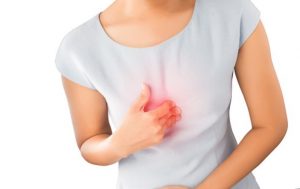 Retrosternal chest pain is pain felt behind the sternum bone—a flat bone located in the middle of the chest. This bone may also be referred to as the breastbone. Due to the relative location of retrosternal pain, it is often confused with various cardiac conditions that can induce unnecessary anxiety in suffers. However, due to the nature of the pain and its presenting symptoms, those who experience retrosternal pain will often be worked up to rule out any potential cardiogenetic cause.
Retrosternal chest pain is pain felt behind the sternum bone—a flat bone located in the middle of the chest. This bone may also be referred to as the breastbone. Due to the relative location of retrosternal pain, it is often confused with various cardiac conditions that can induce unnecessary anxiety in suffers. However, due to the nature of the pain and its presenting symptoms, those who experience retrosternal pain will often be worked up to rule out any potential cardiogenetic cause.
It is estimated that 44.9 percent of people visiting the emergency room for chest pain have acute coronary syndrome, a common cause of chest pain.
Advertisement
Retrosternal chest pain is commonly seen in most people at some point in their lives with levels of pain varying from person to person. This makes it difficult to fully diagnose the condition on the first presentation.
Many other structures lay beneath the sternum such as the heart, blood vessels, and the esophagus, all of which may be compromised in some way.
Retrosternal pain in chest and causes
There is a multitude of different reasons as to why retrosternal chest pain develops. Not all cases are serious enough to warrant immediate medical attention, however, others do. The following are some causes of retrosternal chest pain.
Gastrointestinal problems: Perhaps the most common cause of retrosternal chest pain, as the esophagus lies behind the sternum. Conditions such as acid reflux can lead to pain and are often confused with a heart problem.
Respiratory problems: Disorders of the respiratory tract can lead to retrosternal pain and can be quite severe. Conditions such as hemothorax (blood between the chest wall and the lung), pneumothorax (air between the chest wall and lung), pneumonia, and pleuritis are all possible causes of retrosternal chest pain. Cancer in the mediastinum tissue or bronchus can also be appreciated as retrosternal chest pain.
Cardiac problems: By far the most worrisome complication that medical professionals want to rule out first. Heart attacks, heart fibrillation, pericarditis, angina, and mitral valve prolapse are all problems that can mimic more benign causes of retrosternal chest pain.
Tumors: Tumors found near the sternum, whether benign or malignant, can be a major cause of retrosternal chest pain. They will need imaging studies such as an MRI or CT scan to confirm and begin treatment.
Retrosternal pain in chest and its symptoms
Advertisement
Depending on the specific cause of the retrosternal chest pain, symptoms will differ. However, the common feature across all cases will be mild to severe chest pain. Retrosternal chest pain might be abrupt, or it could remain mild for several days before becoming severe.
Retrosternal chest pain is commonly described as stinging, agonizing, compressing, and/or crushing in nature. The features that physicians rely on are associated symptoms that often accompany retrosternal chest pain and point to the particular underlying cause. Some associated symptoms include:
- Sour taste in the mouth. This may occur at night or when you lay down, as it is commonly due to acid reflux disease.
- Difficulty swallowing solid food. A sign that the esophagus is obstructed in some fashion, possibly hinting at possible cancer.
- Pain while breathing, cough, or fever. All are accompanying signs of respiratory disease that can produce retrosternal pain during normal breathing.
- Radiating pain to the arm. A common sign associated with cardiogenic problems that requires medical attention as soon as possible. Other signs of possible heart issues are a change in color of the nails and tongue, increased heart rate, perspiration, breathlessness, dizziness, and vomiting.
Retrosternal pain in chest treatment
Retrosternal chest pain treatment relies upon correctly identifying the underlying cause. Once this has been achieved, proper treatment can ensue. Cardiac issues will often need to be assessed in depth, as minor invasive procedures need to be done to properly treat the cause of chest pain. This is especially true in acute coronary artery syndrome patients, where the blood vessels of the heart becoming significantly blocked, restricting blood flow. In more common causes of retrosternal chest pain, however—such as with acid reflux—the use of medications to reduce stomach acid is commonly implemented.
